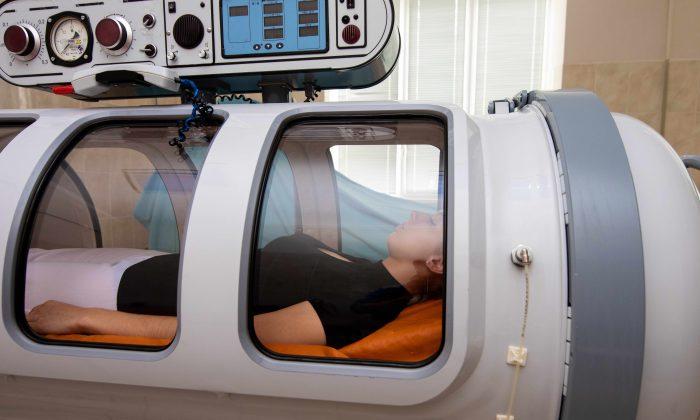Our bodies need oxygen to function. When we breathe, it’s brought into our lungs and transported by our red blood cells to our bodies. It’s then used to produce energy and sustain life.
Hyperbaric oxygen therapy (HBOT) involves supplying the body’s blood and tissues with pure oxygen in order to promote healing. Hyperbaric medicine was first used in the 1600s, when patients went into airtight chambers that could be compressed and decompressed. In the United States, HBOT was used in the early 20th century to treat the flu and then again in the 1940s to treat decompression sickness among Navy deep sea divers (aka, “the bends”).
What Is a Hyperbaric Chamber?
A hyperbaric chamber is a pressurized tube or room that provides pure oxygen in air pressure levels that are up to three times higher than average.What Is Hyperbaric Oxygen Therapy?
Hyperbaric oxygen therapy involves increasing your exposure to pure oxygen in a pressurized room or tube. When you breathe inside the hyperbaric chamber, your lungs are able to gather up to three times more oxygen than they would normally, allowing the oxygen to enter your blood and promote healing.- decompression sickness
- anemia due to severe blood loss
- carbon monoxide poisoning
- chronic wounds that don’t respond to conventional treatment
- radiation wounds or injury
- thermal burns caused by heat or fire
- skin grafts
- serious infections
- gangrene
- air or gas embolism, which occurs when bubbles enter a vein or artery
- arterial insufficiency, which occurs when flow blood slows or stops through arteries
Hyperbaric Oxygen Therapy Benefits
1. Used to Treat Decompression Sickness
Decompression sickness is a condition that sometimes occurs in deep sea divers, mountain climbers, or people who work at very high or low altitudes. The condition is caused by bubbles of nitrogen and other gases forming in the bloodstream, leading to severe joint pain, dizziness, and shortness of breath.2. Fights Serious Infections
Hyperbaric oxygen therapy is used in the management of serious infections, like diabetic foot infections, fungal infections, neurosurgical infections, gangrene, and necrotizing fasciitis (also known as flesh-eating disease). HBOT acts as an antibacterial agent by increasing the formation of free oxygen radicals.3. Heals Chronic Wounds
Hyperbaric oxygen therapy is sometimes used for the treatment of chronic wounds because it works to improve oxygenation and promote the formation of new blood vessels. Hyperbaric oxygen therapy can also help to decrease inflammation in chronic wounds and decrease the likelihood of negative events, such as amputation, according to research published in Advances in Skin and Wound Care.4. May Improve Neurodegenerative Diseases
Hyperbaric oxygen therapy has shown to improve neurological functions and quality of life for people who are recovering from incidents such as stroke and traumatic brain injury. It is also used to improve the symptoms of some neurodegenerative diseases, including Alzheimer’s, though some experts, including the Mayo Clinic, warn that more evidence is needed.5. Used for Carbon Monoxide Poisoning
HBOT can be used in cases of carbon monoxide poisoning, which displaces oxygen in the bloodstream. Studies have shown that under certain conditions, HBOT can reduce the risk of brain injury and nerve damage following carbon monoxide poisoning.How to Find, Use Hyperbaric Oxygen Therapy
To receive hyperbaric oxygen therapy, you’ll likely visit an outpatient center that has single chambers or multi-person chambers. Chambers made for one person is typically a clear plastic tube. The patient will lie on a table that then slides into the tube. For multi-person chambers, patients typically sit in provided seats and wear a mask that’s hooked up to an oxygen machine. Some chambers even allow patients to listen to music or watch TV as they undergo treatment.A hyperbaric oxygen therapy session can last anywhere from 30 minutes to two hours. And the number of sessions a patient must undergo depends on his or her condition. For the treatment of chronic wounds, 20 to 40 HBOT sessions may be necessary.
Talk to your health care professional about the possibility of using hyperbaric oxygen therapy for your specific condition. If he or she deems it appropriate, your doctor should be able to recommend an outpatient facility that offers this type of therapy. Hyperbaric oxygen therapy is approved by most major health insurance companies when it’s approved for your particular condition. One HBOT session costs about $350, but this depends on the location, and you can expect to pay a copay for each session.
Potential Risks and Side Effects
When HBOT is used for conditions that have been deemed appropriate by the FDA, it is usually well tolerated with few side effects. However, some patients using hyperbaric oxygen therapy may experience mild side effects such as sinus pain, ear pressure, and painful joints.Some patients experience claustrophobia when they’re inside the hyperbaric chambers and people with diabetes may experience a drop in blood sugar during treatment, so they should eat before entering the chamber and monitor their blood glucose levels.
More serious hyperbaric oxygen therapy side effects include difficulty breathing, seizures, paralysis, and air embolism, which is when air bubbles enter a vein or artery. Although it’s rare, hyperbaric chambers can be dangerous because they increase the risk of fire, which is due to the chamber’s oxygen-rich environment. But generally, a chamber is a safe environment when it’s handled by a professional with appropriate training.
The FDA is concerned that patients may be led to believe that hyperbaric oxygen therapy is safe and effective for serious medical conditions and they may choose to delay or forgo proven medical therapies, thereby worsening their existing conditions.
Some conditions that hyperbaric oxygen therapy hasn’t been cleared for include HIV/AIDS, stroke, Parkinson’s disease, Alzheimer’s disease, multiple sclerosis, depression, Bell’s palsy, cerebral palsy, and brain injury.



Friends Read Free